An Overview of Regulation Topologies in Resonant Wireless Power Transfer Systems for Consumer Electronics or Bio-Implants
Abstract
:1. Introduction
2. RX Regulation
2.1. Post-Stage Regulation
2.1.1. The Rectifier Cascaded by an LDO
2.1.2. The Rectifier Cascaded by a DC–DC Converter
2.1.3. The Rectifier Cascaded by an Inductorless Switching Converter
2.2. One-Stage Regulation
2.2.1. Active Diode Conduction Time Control
2.2.2. Reconfigurable Regulating Rectification
2.2.3. Switching-Based Current-Mode Regulation
3. TX Regulation
3.1. Why TX Regulation is Necessary
3.2. Power Amplifier Supply Voltage Control
3.3. Resonant Frequency Control
3.4. PA Power Switch Duty-Cycle Control
3.4.1. Switching Frequency Modulation
3.4.2. Pulse Density Modulation
3.4.3. Phase-Shifted Modulation
3.5. Vector Power Summing Control
4. Discussions and Development Trends
5. Conclusions
Author Contributions
Acknowledgments
Conflicts of Interest
References
- Chiaraviglio, L.; D’Andreagiovanni, F.; Lancellotti, R.; Shojafar, M.; Melazzi, N.B.; Canali, C. An Approach to Balance Maintenance Costs and Electricity Consumption in Cloud Data Centers. IEEE Trans. Sustain. Comput. 2018, 1–15. [Google Scholar] [CrossRef]
- Chiaraviglio, L.; Blefari-Melazzi, N.; Canali, C.; Cuomo, F.; Lancellotti, R.; Shojafar, M. A Measurement-Based Analysis of Temperature Variations Introduced by Power Management on Commodity Hardware. In Proceedings of the 2017 19th International Conference on Transparent Optical Networks (ICTON), Girona, Spain, 2–6 July 2017; pp. 1–4. [Google Scholar]
- Mayordomo, I.; Drager, T.; Spies, P.; Bernhard, J.; Pflaum, A. An Overview of Technical Challenges and Advances of Inductive Wireless Power Transmission. Proc. IEEE 2013, 101, 1302–1311. [Google Scholar] [CrossRef]
- Covic, G.A.; Boys, J.T. Inductive Power Transfer. Proc. IEEE 2013, 101, 1276–1289. [Google Scholar] [CrossRef]
- Agarwal, K.; Jegadeesan, R.; Guo, Y.X.; Thakor, N.V. Wireless Power Transfer Strategies for Implantable Bioelectronics: Methodological Review. IEEE Rev. Biomed. Eng. 2017, 10, 136–161. [Google Scholar] [CrossRef] [PubMed]
- Dai, J.; Ludois, D.C. A Survey of Wireless Power Transfer and a Critical Comparison of Inductive and Capacitive Coupling for Small Gap Applications. IEEE Trans. Power Electron. 2015, 30, 6017–6029. [Google Scholar] [CrossRef]
- Jiang, C.; Chau, K.T.; Liu, C.; Lee, C.H.T. An Overview of Resonant Circuits for Wireless Power Transfer. Energies 2017, 10, 894. [Google Scholar] [CrossRef]
- Zhou, D.D.; Greenbaum, E. Implantable Neural Prostheses 2: Techniques and Engineering Approaches; Springer: New York, NY, USA, 2010; ISBN 978-0-387-98119-2. [Google Scholar]
- Ishida, K.; Yasufuku, T.; Miyamoto, S.; Nakai, H.; Takamiya, M.; Sakurai, T.; Takeuchi, K. 1.8 V Low-Transient-Energy Adaptive Program-Voltage Generator Based on Boost Converter for 3D-Integrated NAND Flash SSD. IEEE J. Solid-State Circuits 2011, 46, 1478–1487. [Google Scholar] [CrossRef] [Green Version]
- Pagano, R.; Baker, M.; Radke, R.E. A 0.18-μm Monolithic Li-Ion Battery Charger for Wireless Devices Based on Partial Current Sensing and Adaptive Reference Voltage. IEEE J. Solid-State Circuits 2012, 47, 1355–1368. [Google Scholar] [CrossRef]
- Huang, M.; Lu, Y.; Seng-Pan, U.; Martins, R.P. 22.4 A Reconfigurable Bidirectional Wireless Power Transceiver with Maximum-Current Charging Mode and 58.6% Battery-to-Battery Efficiency. In Proceedings of the IEEE International Solid-State Circuits Conference (ISSCC), Digest of Technical Papers, San Francisco, CA, USA, 5–9 February 2017; pp. 376–377. [Google Scholar]
- Wu, C.Y.; Qian, X.H.; Cheng, M.S.; Liang, Y.A.; Chen, W.M. A 13.56 MHz 40 mW CMOS High-Efficiency Inductive Link Power Supply Utilizing On-Chip Delay-Compensated Voltage Doubler Rectifier and Multiple LDOs for Implantable Medical Devices. IEEE J. Solid-State Circuits 2014, 49, 2397–2407. [Google Scholar] [CrossRef]
- Lee, H. An Auto-Reconfigurable AC-DC Regulator for Wirelessly Powered Biomedical Implants With 28% Link Efficiency Enhancement. IEEE Trans. Very Large Scale Integr. VLSI Syst. 2016, 24, 1598–1602. [Google Scholar] [CrossRef]
- Kiani, M.; Lee, B.; Yeon, P.; Ghovanloo, M. 12.7 A Power-Management ASIC with Q-modulation Capability for Efficient Inductive Power Transmission. In Proceedings of the IEEE International Solid-State Circuits Conference (ISSCC), Digest of Technical Papers, San Francisco, CA, USA, 22–26 February 2015; pp. 226–228. [Google Scholar]
- Lee, H.M.; Ghovanloo, M. An Integrated Power-Efficient Active Rectifier with Offset-Controlled High-Speed Comparators for Inductively Powered Applications. IEEE Trans. Circuits Syst. Regul. Pap. 2011, 58, 1749–1760. [Google Scholar] [CrossRef] [PubMed]
- Moh, K.G.; Neri, F.; Moon, S.; Yeon, P.; Yu, J.; Cheon, Y.; Roh, Y. s; Ko, M.; Park, B.H. 12.9 A Fully Integrated 6W Wireless Power Receiver Operating at 6.78MHz with Magnetic Resonance Coupling. In Proceedings of the IEEE International Solid-State Circuits Conference (ISSCC), Digest of Technical Papers, San Francisco, CA, USA, 22–26 February 2015; pp. 230–232. [Google Scholar]
- Choi, J.-H.; Yeo, S.-K.; Park, S.; Lee, J.-S.; Cho, G.-H. Resonant Regulating Rectifiers (3R) Operating for 6.78 MHz Resonant Wireless Power Transfer (RWPT). IEEE J. Solid-State Circuits 2013, 48, 2989–3001. [Google Scholar] [CrossRef]
- Park, Y.J.; Jang, B.; Park, S.M.; Ryu, H.C.; Oh, S.J.; Kim, S.Y.; Pu, Y.; Yoo, S.S.; Hwang, K.C.; Yang, Y.; et al. A Triple-Mode Wireless Power-Receiving Unit With 85.5% System Efficiency for A4WP, WPC, and PMA Applications. IEEE Trans. Power Electron. 2018, 33, 3141–3156. [Google Scholar] [CrossRef]
- Moon, Y.J.; Roh, Y.S.; Yoo, C.; Kim, D.Z. A 3.0-W Wireless Power Receiver Circuit with 75-% Overall Efficiency. In Proceedings of the IEEE Asian Solid-State Circuits Conference (A-SSCC), Kobe, Japan, 12–14 November 2012; pp. 97–100. [Google Scholar]
- Park, H.G.; Jang, J.H.; Kim, H.J.; Park, Y.J.; Oh, S.; Pu, Y.; Hwang, K.C.; Yang, Y.; Lee, K.Y. A Design of a Wireless Power Receiving Unit with a High-Efficiency 6.78-MHz Active Rectifier Using Shared DLLs for Magnetic-Resonant A4WP Applications. IEEE Trans. Power Electron. 2016, 31, 4484–4498. [Google Scholar] [CrossRef]
- Kim, C.; Ha, S.; Park, J.; Akinin, A.; Mercier, P.P.; Cauwenberghs, G. A 144-MHz Fully Integrated Resonant Regulating Rectifier with Hybrid Pulse Modulation for Mm-Sized Implants. IEEE J. Solid-State Circuits 2017, 52, 3043–3055. [Google Scholar] [CrossRef]
- Lee, H.M.; Park, H.; Ghovanloo, M. A Power-Efficient Wireless System with Adaptive Supply Control for Deep Brain Stimulation. IEEE J. Solid-State Circuits 2013, 48, 2203–2216. [Google Scholar] [CrossRef] [PubMed]
- Ozalevli, E.; Femia, N.; Capua, G.D.; Subramonian, R.; Du, D.; Sankman, J.; Markhi, M.E. A Cost-Effective Adaptive Rectifier for Low Power Loosely Coupled Wireless Power Transfer Systems. IEEE Trans. Circuits Syst. Regul. Pap. 2017, 1–12. [Google Scholar] [CrossRef]
- Li, X.; Tsui, C.-Y.; Ki, W.-H. A 13.56 MHz Wireless Power Transfer System with Reconfigurable Resonant Regulating Rectifier and Wireless Power Control for Implantable Medical Devices. IEEE J. Solid-State Circuits 2015, 50, 978–989. [Google Scholar] [CrossRef]
- Cheng, L.; Ki, W.H.; Tsui, C.Y. A 6.78-MHz Single-Stage Wireless Power Receiver Using a 3-Mode Reconfigurable Resonant Regulating Rectifier. IEEE J. Solid-State Circuits 2017, 52, 1412–1423. [Google Scholar] [CrossRef]
- Lee, H.M.; Ghovanloo, M. An Adaptive Reconfigurable Active Voltage Doubler/Rectifier for Extended-Range Inductive Power Transmission. In Proceedings of the IEEE International Solid-State Circuits Conference (ISSCC), Digest of Technical Papers, San Francisco, CA, USA, 19–23 February 2012; pp. 286–288. [Google Scholar]
- Lu, Y.; Li, X.; Ki, W.H.; Tsui, C.Y.; Yue, C.P. A 13.56MHz Fully Integrated 1X/2X Active Rectifier with Compensated Bias Current for Inductively Powered Devices. In Proceedings of the IEEE International Solid-State Circuits Conference (ISSCC), Digest of Technical Papers, San Francisco, CA, USA, 17–21 February 2013; pp. 66–67. [Google Scholar]
- Kiani, M.; Lee, B.; Yeon, P.; Ghovanloo, M. A Q-Modulation Technique for Efficient Inductive Power Transmission. IEEE J. Solid-State Circuits 2015, 50, 2839–2848. [Google Scholar] [CrossRef] [PubMed]
- Ahn, D.; Kim, S.; Moon, J.; Cho, I.-K. Wireless Power Transfer with Automatic Feedback Control of Load Resistance Transformation. IEEE Trans. Power Electron. 2016, 31, 7876–7886. [Google Scholar] [CrossRef]
- Lee, B.; Yeon, P.; Ghovanloo, M. A Multicycle Q-Modulation for Dynamic Optimization of Inductive Links. IEEE Trans. Ind. Electron. 2016, 63, 5091–5100. [Google Scholar] [CrossRef] [PubMed] [Green Version]
- Gougheri, H.S.; Kiani, M. Current-Based Resonant Power Delivery with Multi-Cycle Switching for Extended-Range Inductive Power Transmission. IEEE Trans. Circuits Syst. Regul. Pap. 2016, 63, 1543–1552. [Google Scholar] [CrossRef]
- Li, X.; Tsui, C.Y.; Ki, W.H. 12.8 Wireless Power Transfer System Using Primary Equalizer for Coupling- and Load-Range Extension in Bio-implant Applications. In Proceedings of the IEEE International Solid-State Circuits Conference (ISSCC), Digest of Technical Papers, San Francisco, CA, USA, 22–26 February 2015; pp. 228–230. [Google Scholar]
- Wang, G.; Liu, W.; Sivaprakasam, M.; Kendir, G.A. Design and Analysis of an Adaptive Transcutaneous Power Telemetry for Biomedical Implants. IEEE Trans. Circuits Syst. Regul. Pap. 2005, 52, 2109–2117. [Google Scholar] [CrossRef]
- Si, P.; Hu, A.P.; Malpas, S.; Budgett, D. A Frequency Control Method for Regulating Wireless Power to Implantable Devices. IEEE Trans. Biomed. Circuits Syst. 2008, 2, 22–29. [Google Scholar] [CrossRef] [PubMed]
- Shinoda, R.; Tomita, K.; Hasegawa, Y.; Ishikuro, H. Voltage-Boosting Wireless Power Delivery System with Fast Load Tracker by ΔΣ-modulated Sub-Harmonic Resonant Switching. In Proceedings of the IEEE International Solid-State Circuits Conference (ISSCC), Digest of Technical Papers, San Francisco, CA, USA, 19–23 February 2012; pp. 288–290. [Google Scholar]
- Li, X.; Li, Y.P.; Tsui, C.Y.; Ki, W.H. Wireless Power Transfer System with ΔΣ-Modulated Transmission Power and Fast Load Response for Implantable Medical Devices. IEEE Trans. Circuits Syst. II Express Briefs 2017, 64, 279–283. [Google Scholar] [CrossRef]
- Zhong, W.; Hui, S.Y.R. Maximum Energy Efficiency Operation of Series-Series Resonant Wireless Power Transfer Systems Using On-Off Keying Modulation. IEEE Trans. Power Electron. 2018, 33, 3595–3603. [Google Scholar] [CrossRef]
- Li, H.; Wang, K.; Fang, J.; Tang, Y. Pulse Density Modulated ZVS Full-Bridge Converters for Wireless Power Transfer Systems. IEEE Trans. Power Electron. 2018. [Google Scholar] [CrossRef]
- Ye, Z.; Jain, P.K.; Sen, P.C. A Full-Bridge Resonant Inverter with Modified Phase-Shift Modulation for High-Frequency AC Power Distribution Systems. IEEE Trans. Ind. Electron. 2007, 54, 2831–2845. [Google Scholar] [CrossRef]
- Cai, H.; Shi, L.; Li, Y. Harmonic-Based Phase-Shifted Control of Inductively Coupled Power Transfer. IEEE Trans. Power Electron. 2014, 29, 594–602. [Google Scholar] [CrossRef]
- Tomita, K.; Shinoda, R.; Kuroda, T.; Ishikuro, H. 1W 3.3V-to-16.3V Boosting Wireless Power Transfer Circuits with Vector Summing Power Controller. IEEE J. Solid-State Circuits 2012, 47, 2576–2585. [Google Scholar] [CrossRef]
- Kosuge, A.; Hashiba, J.; Kawajiri, T.; Hasegawa, S.; Shidei, T.; Ishikuro, H.; Kuroda, T.; Takeuchi, K. An Inductively Powered Wireless Solid-State Drive System with Merged Error Correction of High-Speed Wireless Data Links and NAND Flash Memories. IEEE J. Solid-State Circuits 2016, 51, 1041–1050. [Google Scholar] [CrossRef]
- Van Schuylenbergh, K.; Puers, R. Inductive Powering: Basic Theory and Application to Biomedical Systems. In Analog Circuits and Signal Processing; Springer: Dordrecht, The Netherlands, 2009; ISBN 978-90-481-2411-4. [Google Scholar]
- Finkenzeller, K. Fundamentals and Applications in Contactless Smart Cards, Radio Frequency Identification and Near-Field Communication, 3rd ed.; Wiley: Chichester, UK; Hoboken, NJ, USA, 2010; ISBN 978-0-470-69506-7. [Google Scholar]
- Kennedy, H.; Bodnar, R.; Lee, T.; Redman-White, W. A self-tuning resonant inductive link transmit driver using quadrature-symmetric phase-switched fractional capacitance. In Proceedings of the IEEE International Solid-State Circuits Conference (ISSCC), Digest of Technical Papers, San Francisco, CA, USA, 5–9 February 2017; pp. 370–371. [Google Scholar]
- Mao, F.; Lu, Y.; Seng-Pan, U.; Martins, R.P. A Reconfigurable Cross-Connected Wireless-Power Transceiver for Bidirectional Device-to-Device Charging with 78.1% Total Efficiency. In Proceedings of the IEEE International Solid-State Circuits Conference (ISSCC), Digest of Technical Papers, San Francisco, CA, USA, 11–15 February 2018; pp. 140–142. [Google Scholar]

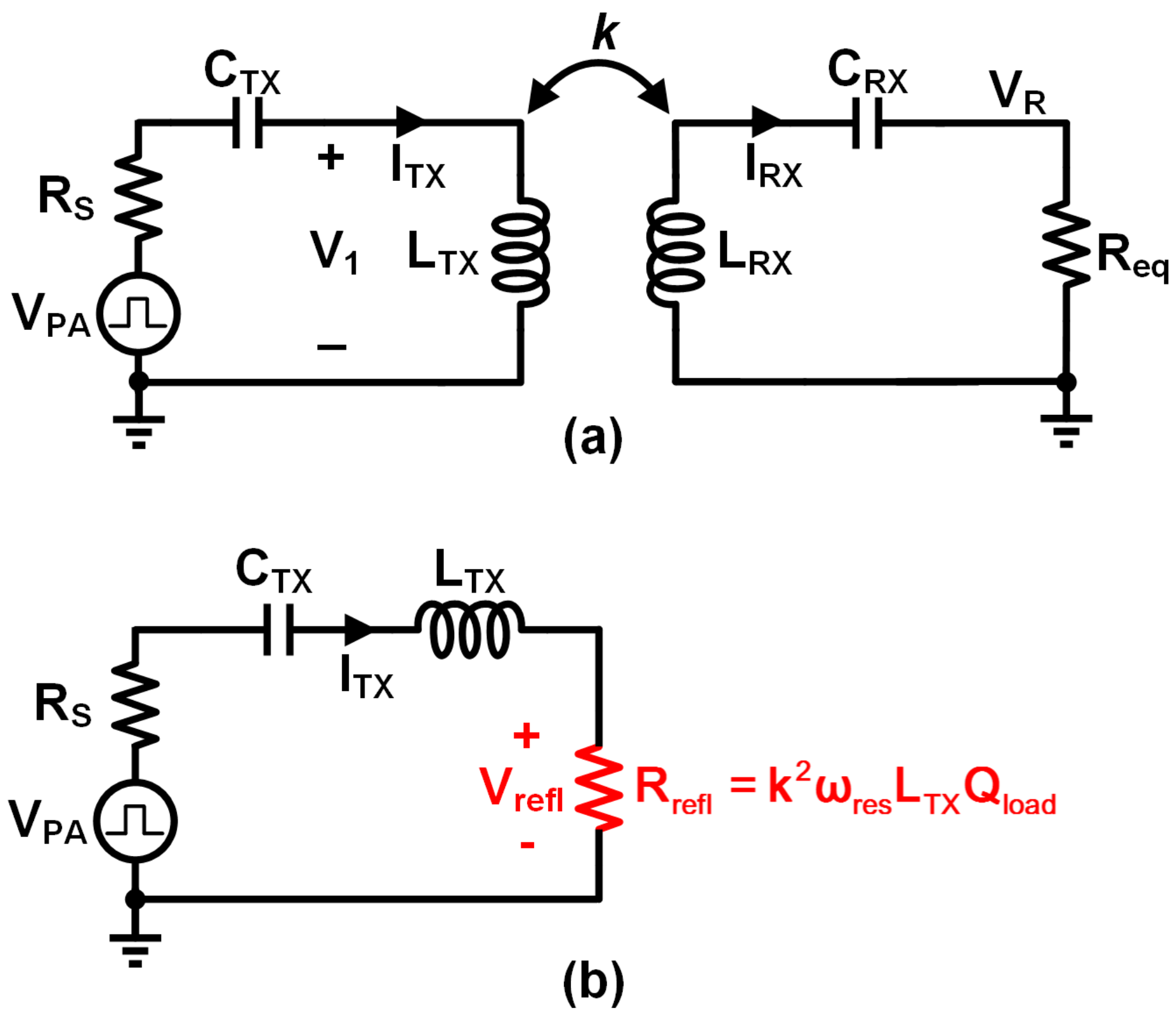

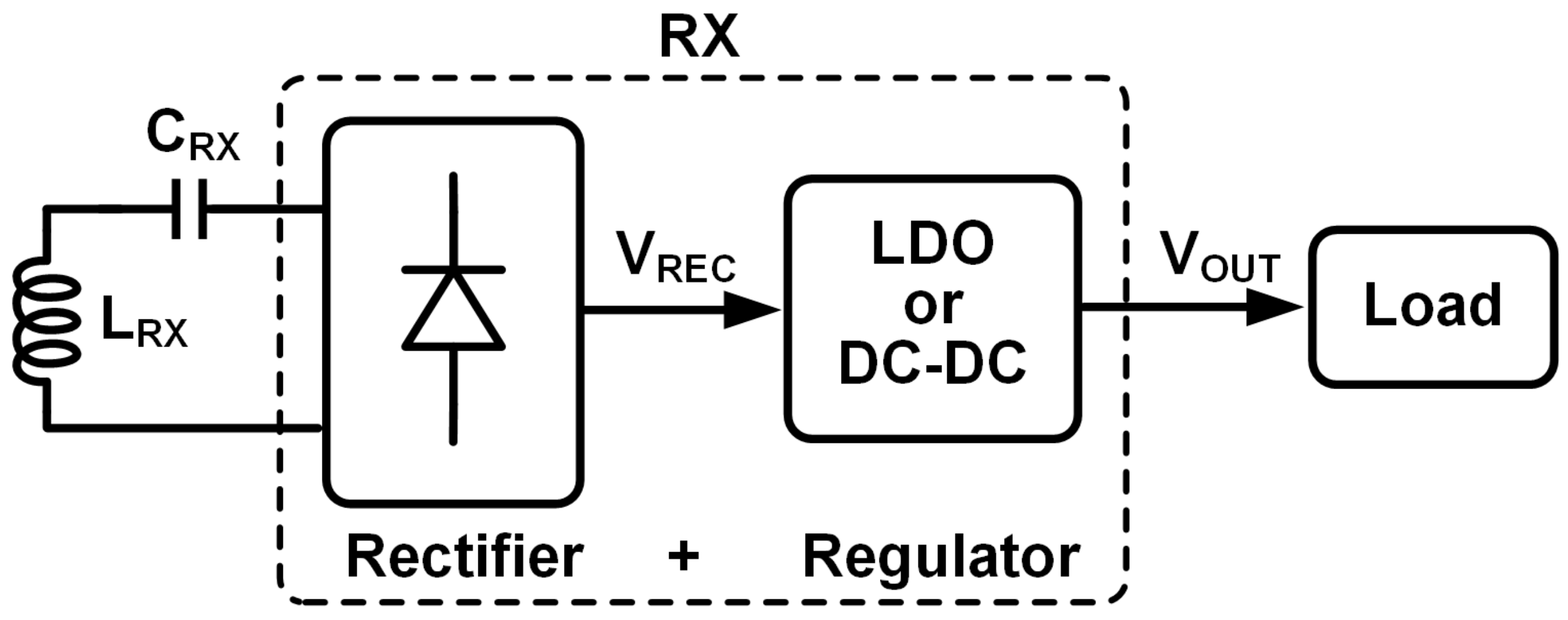




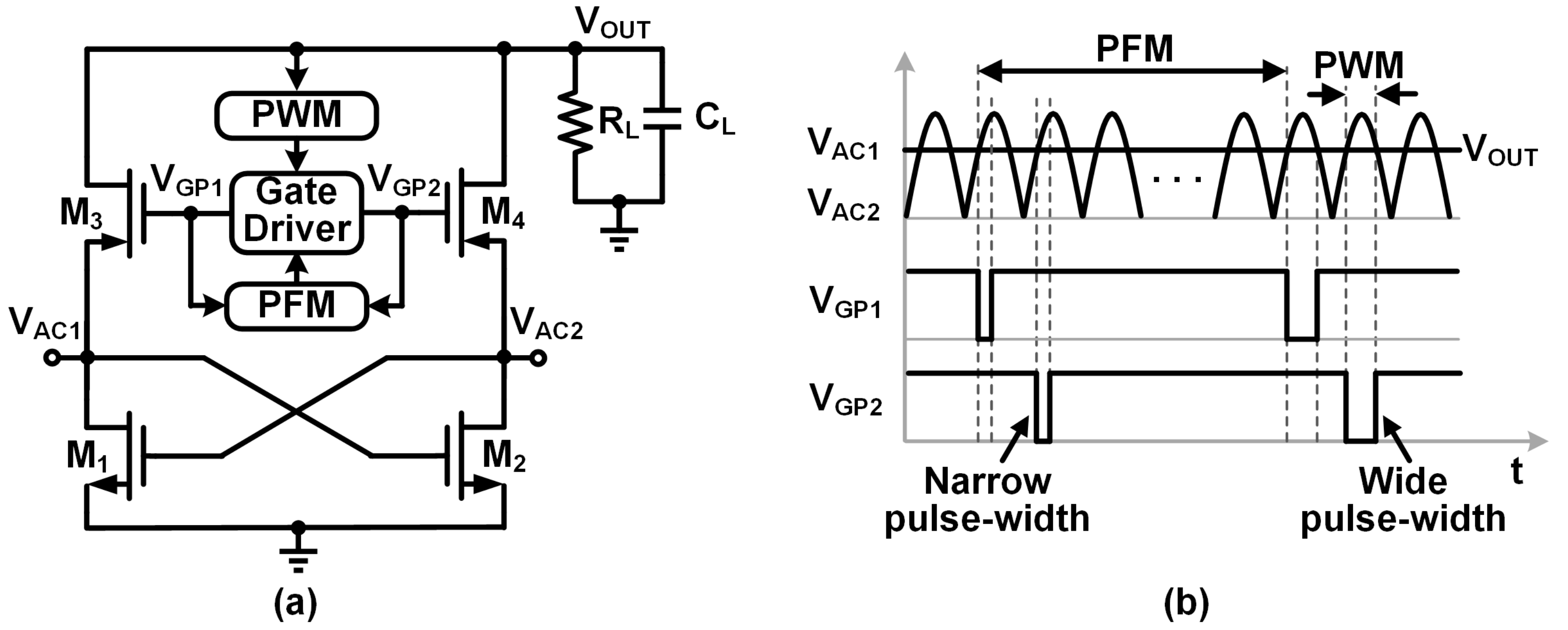




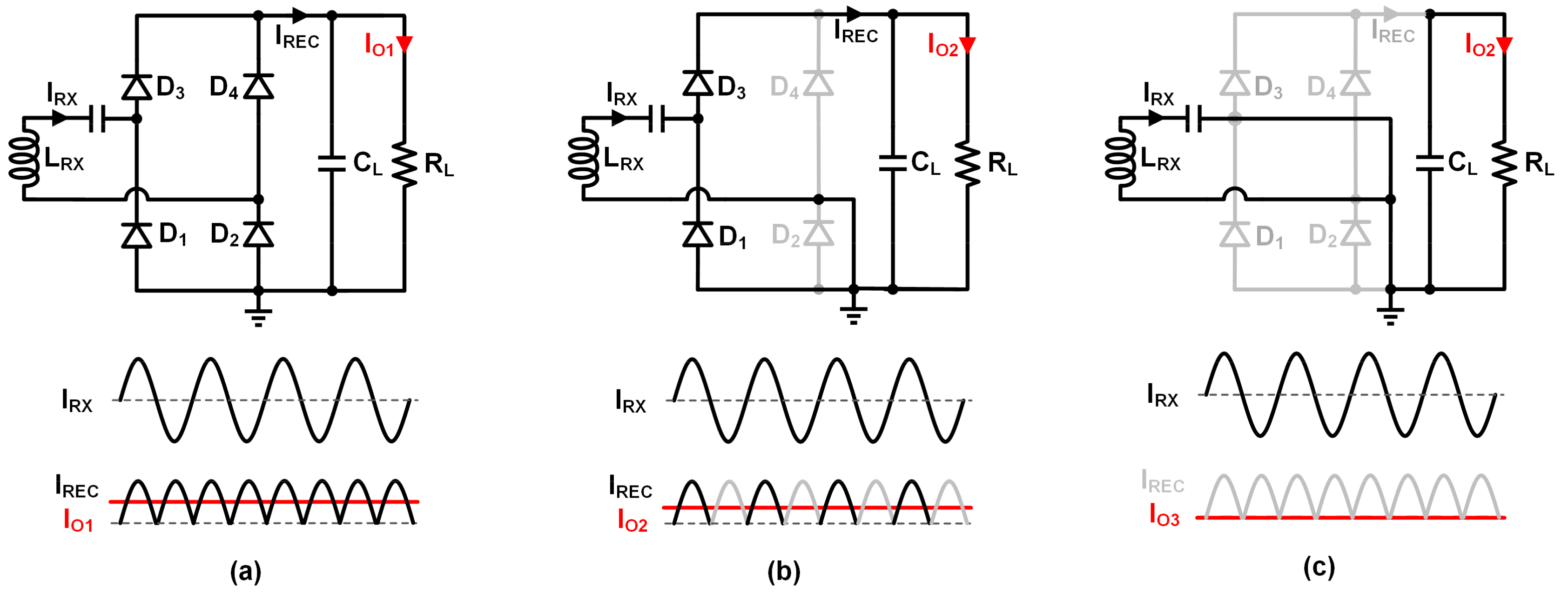


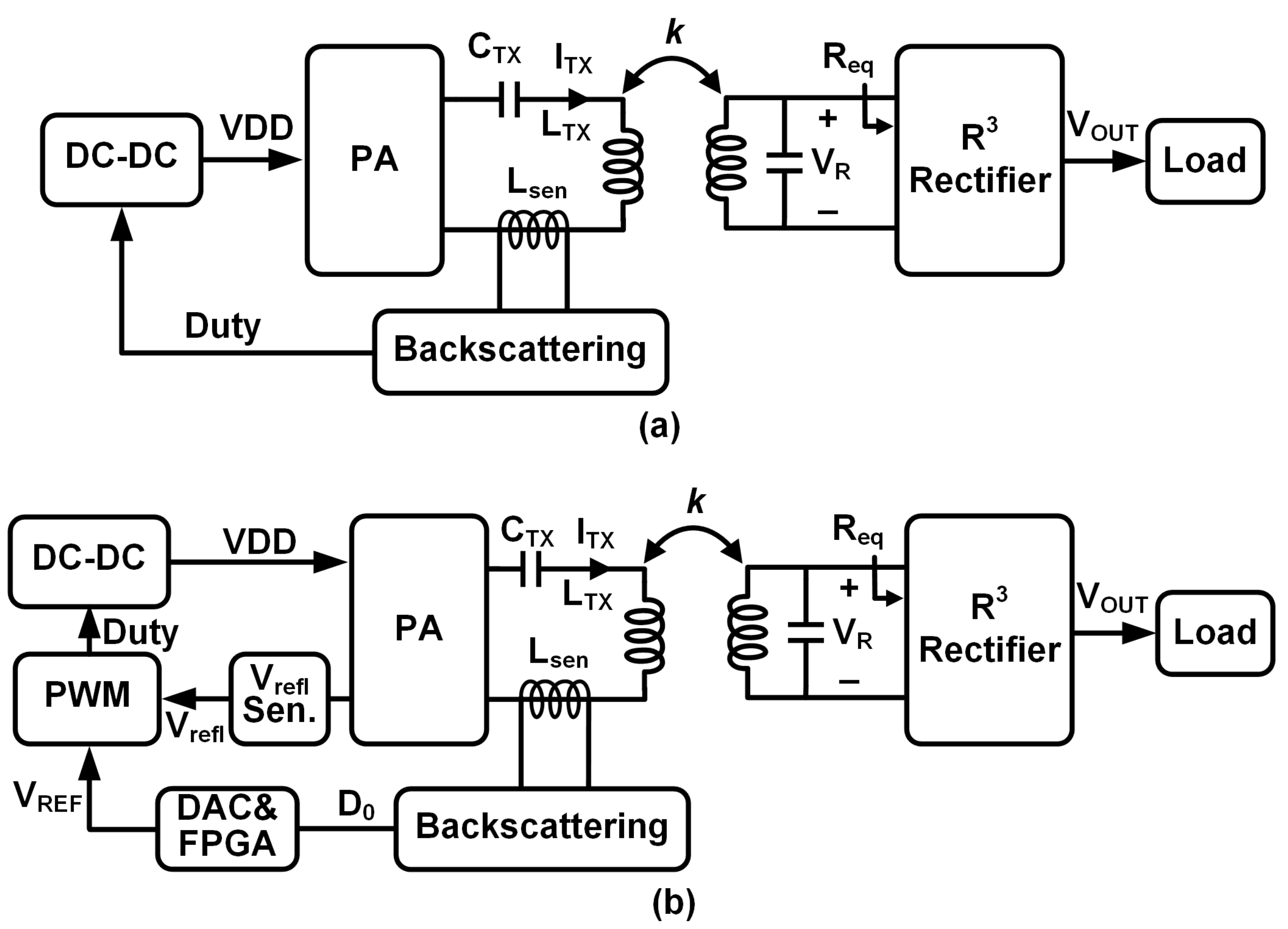




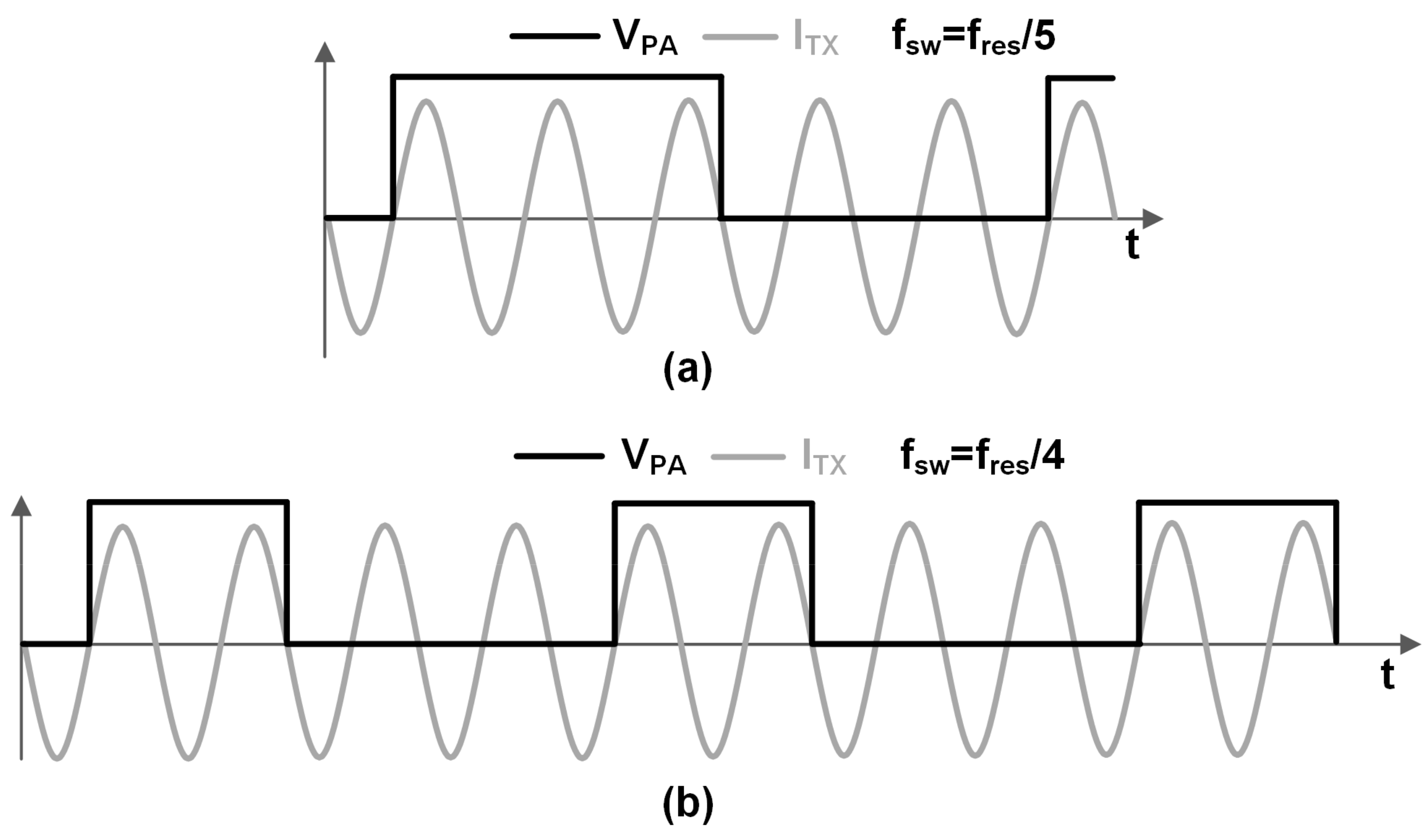



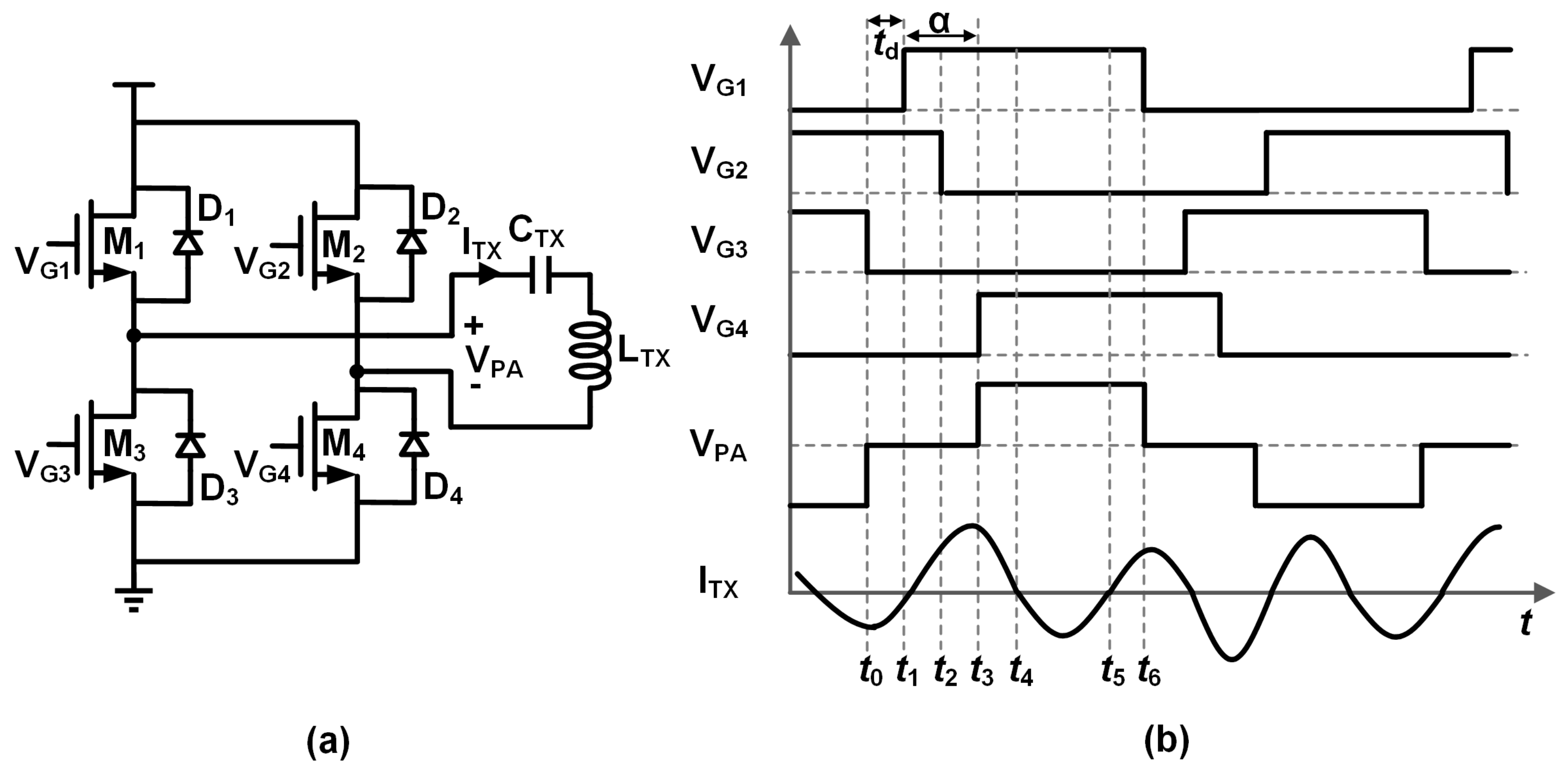
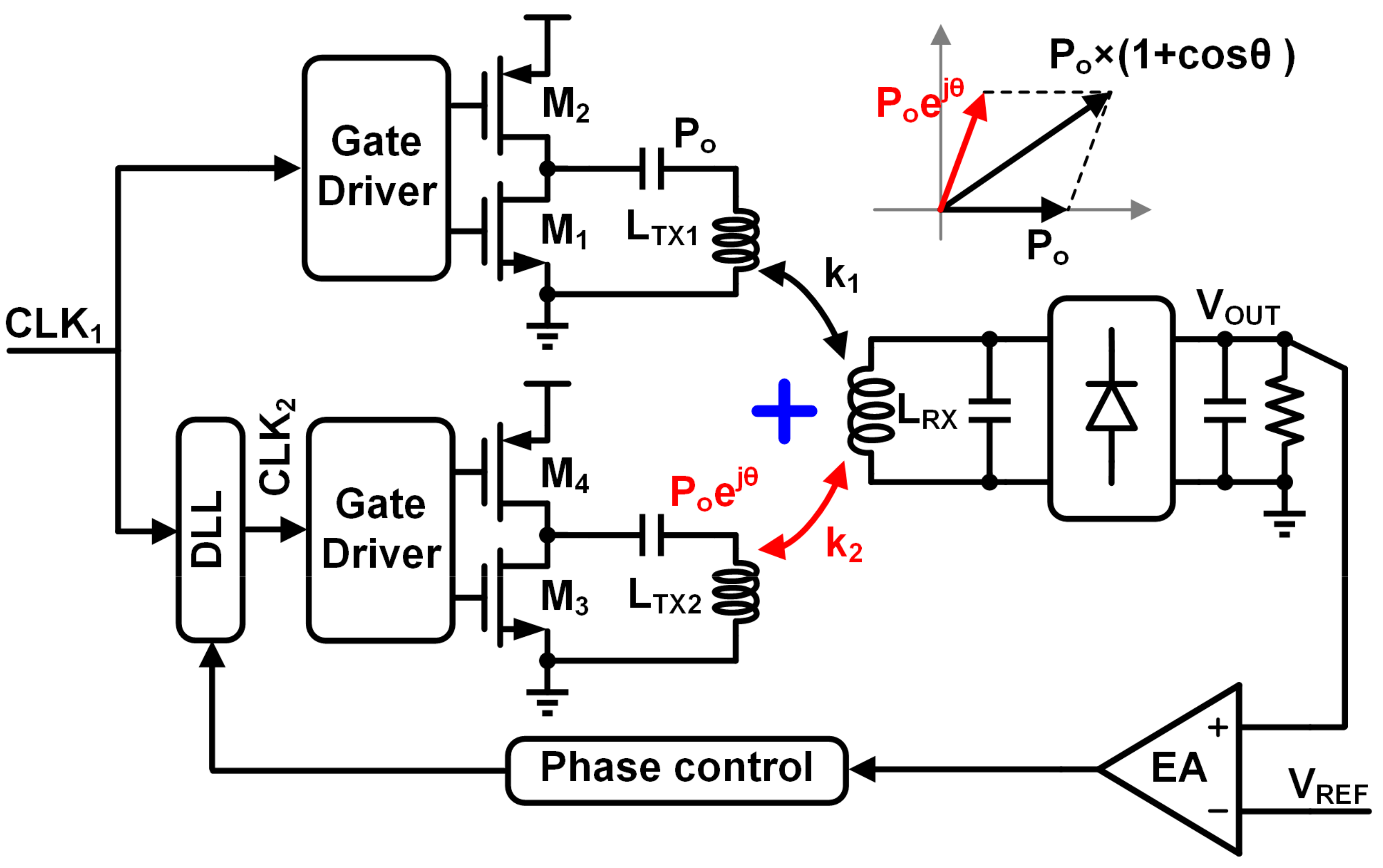
| References | [12] | [16] | [17] | [21] | [22] | [23] | [24] | [25] | [28] | [31] |
|---|---|---|---|---|---|---|---|---|---|---|
| Topology | Post-stage regulation | One-stage regulation | ||||||||
| Max. PDL | 40 mW | 6 W | 6 W | 0.7 mW | 12.8 mW | 2.68 W | 0.1 W | 6 W | 1.45 W | 96 μW # |
| Max. Rectifier Eff. | 85% | 92.8% | 92.5% # | Rectifier efficiency = PCE for one-stage regulation | ||||||
| Max. PCE | 74.8% | 84.6% | 86% | 60% | 87% | 96% | 92.6% | 92.2% | 87.1% | N/A |
| Max. PTE | N/A | N/A | 55% | N/A | N/A | 47.2% | 50% | N/A | ~46% # | 5.3% |
| Max. VCE | N/A | N/A | N/A | 0.92 | 0.92 | N/A | N/A | ~0.9 # | 0.82 # | 3.1 |
| References | [32] | [33] | [34] | [35] | [37] | [39] | [40] | [41] | [42] |
|---|---|---|---|---|---|---|---|---|---|
| Topology | Supply voltage control | fres control | PA power switch duty cycle control | Vector power summing control | |||||
| Max. PDL | 234 mW | 250 mW | 15 W | 0.52 W | 23.2 W | N/A | N/A | 1 W | 1 W |
| Max.PA Eff. | N/A | N/A | 80% | N/A | N/A | 94.5% | N/A | N/A | N/A |
| Max. PTE | 62.4% | 65.8% | N/A | 50% | 72.6% | N/A | 63.94% | 50% | 61.8% |
| Num. of TX | 1 | 2 | |||||||
© 2018 by the authors. Licensee MDPI, Basel, Switzerland. This article is an open access article distributed under the terms and conditions of the Creative Commons Attribution (CC BY) license (http://creativecommons.org/licenses/by/4.0/).
Share and Cite
Liu, Y.; Li, B.; Huang, M.; Chen, Z.; Zhang, X. An Overview of Regulation Topologies in Resonant Wireless Power Transfer Systems for Consumer Electronics or Bio-Implants. Energies 2018, 11, 1737. https://doi.org/10.3390/en11071737
Liu Y, Li B, Huang M, Chen Z, Zhang X. An Overview of Regulation Topologies in Resonant Wireless Power Transfer Systems for Consumer Electronics or Bio-Implants. Energies. 2018; 11(7):1737. https://doi.org/10.3390/en11071737
Chicago/Turabian StyleLiu, Yang, Bin Li, Mo Huang, Zhijian Chen, and Xiuyin Zhang. 2018. "An Overview of Regulation Topologies in Resonant Wireless Power Transfer Systems for Consumer Electronics or Bio-Implants" Energies 11, no. 7: 1737. https://doi.org/10.3390/en11071737






